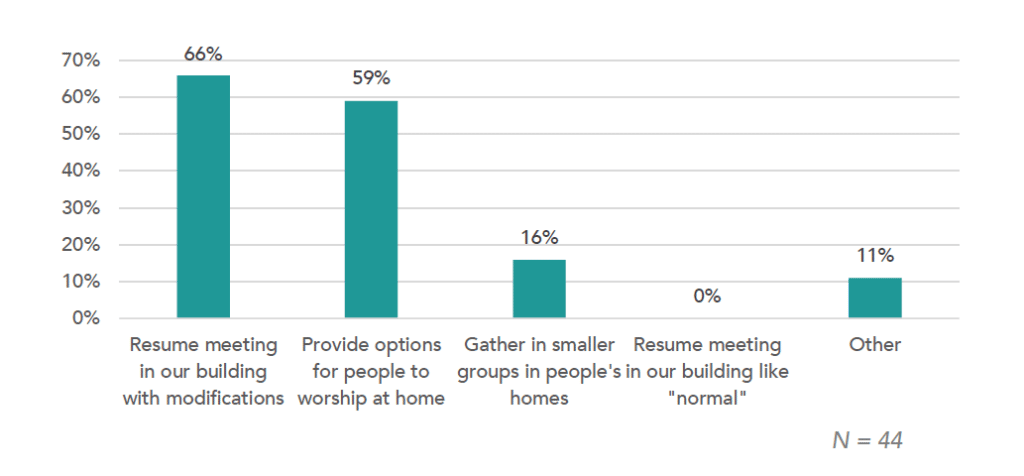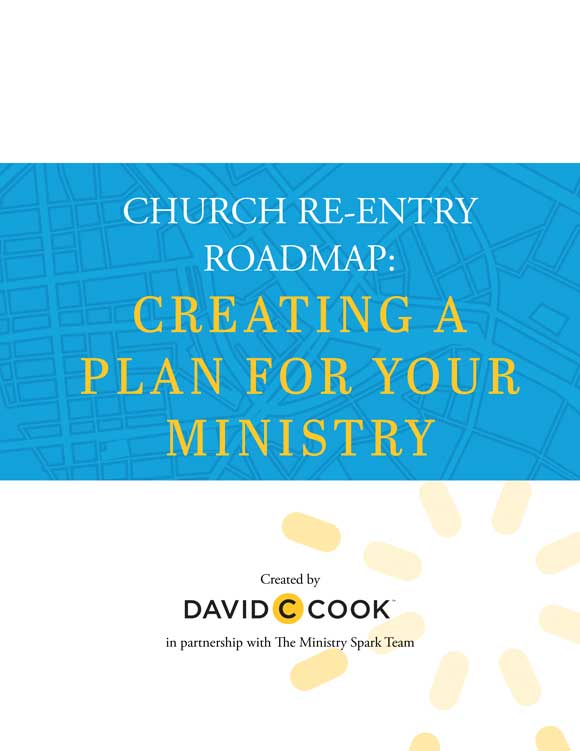Ministry Spark (David C Cook) and Dark Horse Insight, a research and strategy consulting firm, partnered up to survey ministry leaders across the country. We’ve asked them a few questions and will be sharing their comments and stories to help you navigate this time. This is the second article of the series. You can read the first one here.
Our second research point was related to a set of questions detailing their current plans (reopening, virtual), best practices, and resource needs heading into the summer.

The findings fell within the following categories:
- Plans for Returning
- Considerations for Reopening and New Best Practices
- New Operations
- Idea and Resource Needs
Let’s dive in!
Executive Summary
At this time, no participants are planning to return to “business as usual” in the next month. The majority plan to return with modifications, continue online services, or some combination of the two.
For some, a phased reopening will allow initial modifications to decrease over a period of time.
Decisions about reopening are very much still in discussion, and only a few churches have tested their new procedures by actually opening. Plans for when and how to reopen are primarily being based on local, state, and national governmental and broader denominational guidelines.
New strategies for operations include ways to allow for social distancing through adjustments to seating arrangements and traffic flow. Ministry leaders are also evaluating methods to help prevent contact with shared air and surfaces. They’re considering things like encouraging masks, increasing cleaning, and eliminating high-touch objects, such as hymnals, offering plates, and doors that need to be opened.
More specifically, Children’s Ministry Leaders are trying to solve the problems of how to adapt and reopen children’s ministry in accordance with safety guidelines, while continuing to try to provide resources for parents to disciple their children at home and (possibly) participate in family worship services.
They express the need for extended creativity and insights from what others are learning in their various reopening processes.
Plans for Returning
Over the next month, about 2 in 3 respondents’ churches plan to resume meeting in their church building with modifications. Just 3 in 5 plan to continue providing options for online services.
Since participants could check more than one option, we know several are using a combination of the listed options, like having limited in-person services while also keeping services online.
No one said they were planning to return completely to normal within the next month.
Please note: the numbers below are for context only and are not intended to be projectible.

A few respondents who added “other” comments provided insight into the modifications they are planning, such as restrictions by age and plans for cleaning and spacing.
Hear from Ministry Leaders
“As of May 31, people 18+ and under 65, with no health conditions were invited back. Sunday school is offered online, or small groups in homes—left up to leaders and members. Kids and youth all online.”
– Children’s and Adult CE Pastor, Church of 101-300
“We will be opening up in our main sanctuary with provisions (e.g., hand sanitizer, sitting 2 chairs between families). Moving to family services, but the kids and youth ministries are still closed. The conversation we are currently having is social distancing vs. self-governing.”
– Elementary Co-Coordinator, Church size unknown
Those whose plans didn’t fit into the provided options are planning a more phased-in approach, different plans for different aspects of church, or not having plans at all yet.
“We will be continuing worship from home at least through the summer, but within the next month or so will also begin holding an optional smaller, shorter, modified ‘social distancing’ service in the building.”
– Sunday School Pastor, Church of 101-300
“I plan to use Zoom during the week and meet in person on Sunday.”
– Senior Pastor, Church of fewer than 100
“We are not sure when this timeline will take place.”
– Children’s Pastor, Church of 501+
Considerations for Reopening and New Best Practices

Much of the decision process for physically reopening is still in progress. Given that guidelines limit the number of people who can gather, some smaller churches are closer to going back than larger churches, and therefore have more solidified plans.
Only a few churches have actually had an in-person service. And plans for large and small churches seem fairly comparable, with churches taking very similar precautions, regardless of size.
Decision Points for Reopening
Decisions are based first on national, state, local, and denominational guidelines regarding the number of people who can gather and safety precautions that need to be in place. Churches are considering taking it slow and seeing how things look for others after reopening and including church members to help with decision-making.
Church leaders have widely varying ideas about which gatherings are the best place to start, and in this “see what works” environment, it seems that few churches are going to be following the exact same playbook.
One thing most agree on: kids’ ministry will be the last aspect of church to return.
Some churches will start with Sunday service as the only activity, and others will start with midweek adult groups or other limited-attendance groups.
One thing most agree on: kids’ ministry will be the last aspect of church to return. For that reason, most comments focus on a church-wide approach since kidmin is not on the immediate radar for many (including children’s ministry leaders). Some kidmin leaders are looking at whether the local public school is open as a sign that it is safer to restart kidmin gatherings.
Guidelines
“We will be given guidelines from our government and our denomination about when we can gather and what safety practices we need to have in place.”
– Children and Family Pastor, Church of 101-300
“We are waiting for the Governor to give the go-ahead to have larger groups gather. When that happens, we will allow whatever is allowed back in the building … kids’ ministry will start even slower.
We will start first with early childhood once we are allowed to have over 250 people. Full kids’ ministry will open when we can have over 500.”
– Children’s Pastor, Church of 501+
“We are following the guidelines provided by the HHS of the state of Texas, the recommendations for reopening houses of worship from the federal government (FEMA) and the national office of our denomination.”
– Teaching Pastor, Church of Fewer than 100
Take It Slow
“We are cautious, listening to other leaders in our denomination and we are waiting for a time to see if this initial opening causes a spike in numbers. Why open if you just get shut down right away.”
– Marriage and Family Pastor, Church of 101-300
“We are not re-opening until at least end of June and expect to be several phases behind our state.”
– Children’s Pastor, Church of 501+
“We are just walking through this process right now. We have been monitoring what other churches are doing and following our governor’s recommendations at this point … I am very grateful for information sharing from other churches who have started opening their churches and some of the kids’ ministry areas as well.
It’s very helpful to hear things others have done to address specific issues that we know we’ll also face.”
– Children’s Pastor, Church of 501+
Get Input from Your Congregation
“One thing that has been super helpful for us is that as soon as things first started back in the beginning of March, we created a crisis management team with people from our congregation who work out in the community to help us navigate and make decisions.
For instance, we have a media specialist/journalist, a doctor, the head of our security team, someone from the school district, etc.
They meet with our lead pastors and care leaders (leaders assigned to caring for people within a certain zip code, we have about 900 people on a Sunday) to help make decisions and brainstorm ideas.
The doctor on the team has been extremely helpful in helping us create a plan to reopen kids’ ministry. His perspective and input have been so valuable.”
– Children’s Pastor, Church of 501+
“The leadership team is just starting to plan this—they are creating a team to oversee the process. The rough outline is to wait until the number allowed to meet exceeds 100, due to our church size, and we will be distributing a survey to get feedback from the congregation before practices are put into place.
We are currently working on communicating the need for respect, love, and compassion to try and create unity due to differing opinions before we communicate our new policies.”
– Children’s Pastor, Church of 501+
Sundays Only
“We started last Sunday. It was a lot of work figuring out how it would work with 2 services. We blocked off every other row (and changed that in between services).”
– Children’s Pastor, Church of 101-300
“We reopened the church on Sunday, June 7th, for services in person. Sunday morning service will be at 10am. There will be no Sunday school offered at the church building until further notice. We will not offer childcare at this time. Children’s packets will be available for children.”
– Senior Pastor, Church of 101-300
Small Groups Only
“We have a 6-week regathering plan for our on-campus ministries and weekend experience that starts on June 1st.
Midweek adult programming will be the first thing that returns (without childcare and food service) which leads up to limited weekend service times on all of our campuses. The last phase of regathering is a full return to all programming.”
– Youth Pastor, Church of 501+
“I think part of the discussion has been to see if prayer meetings can move back to the building instead of online. Another thing we are looking at is having small groups meet in person again, especially now that the weather is getting nicer!”
– Pastor of Children and Youth Ministries, Church of 101-300
Kidmin Is the Toughest to Reinstate
“Trying to figure out how we are going to do kids’ church is the biggest challenge.”
– CE Lay Leader, Church of 301-500
“There will be no childcare, kids’ services, youth services, fellowship activities, or Sunday school classes.”
– Sunday School Pastor, Church of 101-300
“Kids’ ministry has a stricter illness policy, we will have smaller class sizes, and a specific traffic pattern.”
– Children’s Pastor, Church of 501+
“Eventually we’ll be adding kids’ classes, but having families register in advance so we can keep the numbers down and space them out more, while still having at least one service that has no kids’ option.”
– Children’s Pastor, Church of 501+
“We are asking parents to keep their children seated with them and having no children’s church.”
– Senior Pastor, Church of fewer than 100
Ask: Is the Local School Open?
“I think opening up Sunday school for kids may depend on the number of people that are comfortable returning and whether or not schools are opened. If public schools aren’t opened yet, we may delay the opening of kids’ ministry.”
– Children’s Ministry Volunteer, Church of 101-300
“I think only thing we are considering right now is to do family style worship services until schools are back to ‘normal.’ Then we will re-open kids’ ministry.”
– Children’s Pastor, Church of 301-500
New Operations
New procedures fall into two basic categories: strategies to distance attendees and strategies to limit contact with shared air and surfaces.
Distancing strategies include alterations to seating, traffic flow, what parts of the building are open, number of attendees per service, and typical gathering spots.
Contact-limiting strategies include wearing masks, cleaning, prohibiting food and drink in service, and limiting any surfaces or objects typically touched by more than one person (doors, offering plates, hymnals, bulletins, and child check-in devices).
Distancing Strategies
Seating: “Looking to use the fellowship hall, in addition to the sanctuary, to allow for more space with seating. Big screen TV and room speakers would display the pastor giving his sermon.”
– Executive Pastor, Church of fewer than 100
Traffic flow: “The flow of traffic is highlighted, so coming and going is better (although we shall see if that is followed).”
– Sunday School Volunteer
Limited access: “We propped doors open and roped off all areas except foyer, sanctuary, and main bathrooms.”
– Children’s Pastor, Church of 101-300
Smaller/more services: “We are going to essentially assign meeting times so that we can limit services to 50 people or less (state mandate). Services will be shortened to 30 minutes and staggered, with gaps in between to sanitize surfaces.”
– Sunday School Pastor, Church of 101-300
Discourage gathering: “We have bathroom monitors limit the number of people in a bathroom at a time and encourage people not to linger in our foyer but to head outside after services.”
– Children’s Pastor, Church of 501+
Contact-Limiting Strategies
Masks: “We’ve landed on following the recommendations of our state and county, and to emphasize loving each other well by being thoughtful about masks, distancing, and so on. This is a tough time!”
– Children’s Pastor, Church of 301-500
Increased cleaning: “We will have increased cleaning and sanitation procedures, roped off seating, and keep the door propped open.”
– Children’s Pastor, Church of 501+
No food or drink: “We typically have 30 minutes of coffee and pastries (time of fellowship) before the worship service. We may have to suspend this for a while, since there are only 2 coffee stations for all to use.”
– Executive Pastor, Church of fewer than 100
Doors propped open: “We will be propping all main doors open to minimize touching.”
– Children’s and Adult CE Pastor, Church of 101-300
No-touch offering: “Our offering plates are on stools in the back, so no passing necessary.”
– Sunday School Volunteer, Church of 101-300
No shared items: “We won’t have bulletins, hymnals, or a pass-the-plate offering.”
– Children’s Pastor, Church of 501+
No-touch child check-in: “I think I may for a while we will not do self-check-in in order to cut down on the number of surfaces touched.”
– Children’s Pastor, Church of 301-500
Idea and Resource Needs
Children’s Ministry Leaders are looking for ways to reopen children’s ministries while following safety guidelines.
They are also looking for ideas to promote family worship—at home for those continuing online, and in service where children’s services will resume later than adult services—while continuing to emphasize parents as primary disciples.
Ministry leaders need continued creativity to keep producing resources and engaging with families, especially youth. They would love to continue to hear from other churches who are ahead of them in the reopening process to understand what works or doesn’t work.
Learning from Others’ Experiences
“I appreciate hearing from others about what they are doing. If people are taking surveys from families and volunteers, I’d love some examples of questions.
If people already opened their kids’ ministries back up, I’d love to know if there were things that they didn’t consider that caught them off guard the first couple of times they opened. Things like that would be helpful.”
– Children’s Pastor, Church of 501+
“Wondering what others are preparing for signs or information to help with keeping that safe seating distance—how to have recommendations visible to help all feel most comfortable.”
– Executive Pastor, Church of fewer than 100

Creating a Plan for Your Ministry Post-COVID-19

Creating a Plan for Your Ministry Post-COVID-19









